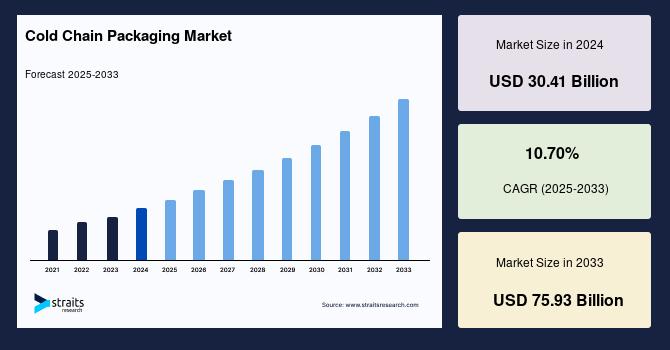Cold Chain Packaging Market: Ensuring Safe Delivery of Temperature-Sensitive Products

The global cold chain packaging market size was valued at USD 30.41 billion in 2024 and is projected to reach from USD 33.67 billion in 2025 to USD 75.93 billion by 2033, growing at a CAGR of 10.70% during the forecast period (2025-2033). This growth reflects the increasing importance of cold chain solutions in sectors such as food, pharmaceuticals, and biotechnology, where maintaining strict temperature controls during storage and transportation is critical for product efficacy and safety.
Understanding Cold Chain Packaging
Cold chain packaging refers to specialized packaging systems designed to maintain controlled temperature conditions throughout the shipment and storage of perishable goods. These packaging solutions prevent spoilage and degradation caused by temperature variations, ensuring that products such as fresh produce, frozen foods, pharmaceuticals, biologics, and vaccines reach their destination in optimal condition. The packaging typically integrates insulated containers, refrigerants, and temperature monitoring technologies to create an effective temperature-controlled environment.
Market Segmentation and Leading Product Types
The market is segmented mainly into three categories: insulated containers, refrigerants, and temperature monitoring systems. Among these, insulated containers hold the largest market share due to their critical role in thermal protection during transportation. These containers often utilize materials such as expanded polystyrene foam (EPS), polyurethane foams, vacuum-insulated panels (VIPs), and newer eco-friendly alternatives like corrugated cardboard-based insulation. They work by minimizing heat transfer to preserve the temperature-sensitive contents for extended periods.
Refrigerants such as gel packs, ice bricks, and phase-change materials complement insulated containers to further stabilize temperatures within shipping units. Meanwhile, temperature monitoring devices including single-use temperature indicators, recorders, and data loggers provide transparency and ensure that cold chain compliance is maintained throughout the supply chain, alerting handlers to any deviations that might compromise product integrity.
Driving Factors Behind Market Growth
Several key factors are propelling the cold chain packaging market’s expansion. The surging demand in the food and beverage sector, particularly for frozen and chilled products like meats, seafood, dairy, fruits, and vegetables, is a principal driver. With rising global urbanization and changing consumer lifestyles, there is a growing preference for convenient, ready-to-eat, and nutrient-preserved foods that necessitate reliable cold chain logistics.
In the pharmaceutical sector, the proliferation of biologics, vaccines, and specialty medicines that require strict temperature control is fueling demand for advanced packaging solutions. The COVID-19 pandemic notably underscored the importance of maintaining ultra-low temperature conditions for vaccine distribution, which accelerated advancements in cold chain technologies.
Geographic Insights and Regional Growth Markets
Europe currently dominates the global cold chain packaging market, maintaining a significant share due to its well-established cold chain infrastructure, stringent regulatory environment, and high consumption of premium perishable products. The region faces growing demand for sustainable packaging solutions that reduce environmental impacts, with companies innovating in the use of biodegradable materials and recyclable packaging options.
North America follows, driven by rising pharmaceutical manufacturing and research activities, along with expanding demand for frozen and chilled foods. The United States and Canada host major pharmaceutical companies investing heavily in temperature-controlled storage and distribution.
Emerging markets in the Asia-Pacific are witnessing rapid growth, propelled by expanding food service industries, increasing consumer awareness about food safety, and governmental initiatives to upgrade cold chain infrastructure. Countries like China and India are notable for their growth in frozen food consumption and efforts to modernize logistics capabilities.
Sustainability and Technological Innovation
Environmental concerns are increasingly influencing cold chain packaging innovations. Market participants are focusing on developing environmentally friendly packaging materials that balance thermal insulation effectiveness with sustainability goals. For instance, cardboard-based insulated packaging alternatives and biodegradable refrigerants are gaining traction as replacements for traditional polystyrene-based materials.
Additionally, the integration of smart technologies such as Internet of Things (IoT) sensors, RFID tags, and GPS tracking systems has revolutionized temperature monitoring. These digital solutions enable real-time tracking and data collection, empowering supply chain managers with actionable insights to minimize risks of temperature excursions and product losses.
Challenges and Future Outlook
Despite the promising growth potential, challenges remain in the cold chain packaging industry. The high cost of advanced packaging materials and sophisticated temperature control systems can be a barrier for small and medium enterprises. Moreover, energy-intensive cooling requirements and complex logistics necessitate ongoing investments in infrastructure and technology upgrades.
Nonetheless, ongoing advancements in material science, sustainable design, and digital monitoring systems are expected to drive efficiencies, reduce costs, and expand market accessibility in the coming years. Collaboration among manufacturers, logistics providers, and regulatory bodies will be crucial to fostering innovation and ensuring compliance with evolving global standards.
Conclusion
The cold chain packaging market is poised for substantial growth over the next decade, fueled by increasing global demand for safe, fresh, and high-quality temperature-sensitive products. With ongoing innovations in sustainable materials and smart packaging technologies, the industry is adapting to meet the dual challenges of supply chain efficiency and environmental responsibility. As consumers and industries become more reliant on sophisticated cold chain logistics, the market will continue to evolve to support the expanding needs of food, pharmaceutical, and biotech sectors worldwide.
- Art
- Causes
- Crafts
- Dance
- Drinks
- Film
- Fitness
- Food
- Oyunlar
- Gardening
- Health
- Home
- Literature
- Music
- Networking
- Other
- Party
- Religion
- Shopping
- Sports
- Theater
- Wellness



